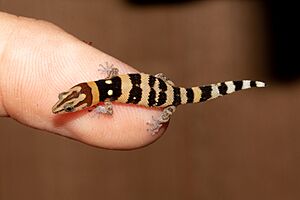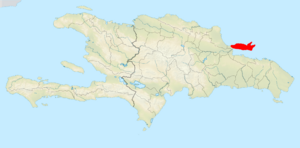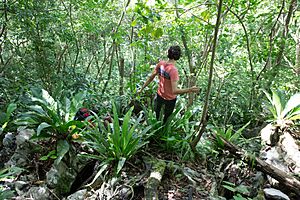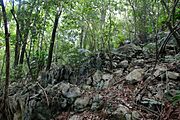Beautifully ringed sphaero facts for kids
Quick facts for kids Beautifully ringed sphaero |
|
|---|---|
 |
|
| A juvenile Sphaerodactylus callocricus | |
| Conservation status | |
| Scientific classification | |
| Genus: |
Sphaerodactylus
|
| Species: |
callocricus
|
The Sphaerodactylus callocricus is a tiny lizard, also known as the beautifully ringed sphaero. People also call it the rough-banded sphaero or rough-banded least gecko. This small gecko belongs to the Sphaerodactylidae family. It lives only in the Dominican Republic.
Contents
Discovering the Beautifully Ringed Sphaero
This special gecko was first described in 1976. A scientist named Albert Schwartz gave it its scientific name. He studied many geckos collected by Louis G. Thompson. These geckos were found in the Samaná Peninsula during snail studies.
What Does the Name Mean?
The name "callocricus" comes from the Greek language. It describes the gecko's cool banded pattern. "Kallos" means "beautiful," and "krikos" means "ring." So, its name means "beautifully ringed."
Where This Gecko Lives
The beautifully ringed sphaero lives only in the Samaná Peninsula. This area is in the eastern part of the Dominican Republic. It is not a common gecko, even there.
It likes to live in karstic forests. These are special forests with lots of limestone rocks. You can find these geckos hiding under stones or fallen leaves. Sometimes, you might even see them walking on the forest floor during the day.
What the Gecko Looks Like
The S. callocricus is a medium-sized gecko for its type. It has scales on its back that are a bit rough and overlap. These are called keeled and imbricate dorsal scales.
These geckos have clear dark bands across their bodies. Their main color is a pale, yellowish-gray. They also have a large dark spot on their shoulders. Inside this spot are two eye-like markings. The head has stripes or blotches that form a "W" shape.
Boy and girl geckos look very similar. Young geckos have brighter patterns. These patterns become a bit lighter as they grow older.
Protecting the Beautifully Ringed Sphaero
The S. callocricus is in big trouble. The IUCN Red List says it is critically endangered. This means it is at a very high risk of disappearing forever.
This gecko lives in a very small area, less than 100 square kilometers. Its home is shrinking fast.
Why This Gecko Is Endangered
The main reasons this gecko is in danger are human activities.
- Tourism development: New hotels and resorts are being built.
- Small-scale agriculture: People are clearing land for small farms.
- Pasture expansion: Forests are cut down to make space for animals to graze.
The S. callocricus needs old, natural karstic forests to survive. These special forests are disappearing quickly from the Samaná Peninsula. This gecko is very sensitive to changes in its home. Because of this, human activities are a big threat. Scientists have even struggled to find these geckos in places where they used to live. This is because their habitat has been changed or destroyed.
Images for kids






